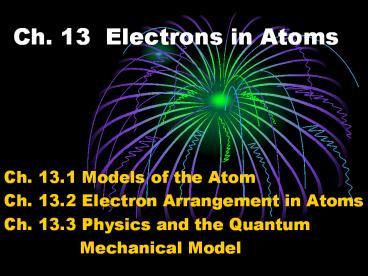Ch. 13 Electrons in Atoms - PowerPoint PPT Presentation
Title:
Ch. 13 Electrons in Atoms
Description:
Ch. 13 Electrons in Atoms Ch. 13.1 Models of the Atom Ch. 13.2 Electron Arrangement in Atoms Ch. 13.3 Physics and the Quantum Mechanical Model – PowerPoint PPT presentation
Number of Views:33
Avg rating:3.0/5.0
Title: Ch. 13 Electrons in Atoms
1
Ch. 13 Electrons in Atoms
- Ch. 13.1 Models of the Atom
- Ch. 13.2 Electron Arrangement in Atoms
- Ch. 13.3 Physics and the Quantum
- Mechanical Model
2
Ch. 13.1 Models of the Atom
- Evolution of Atomic Models
- John Dalton atomic theory
- JJ Thomson plum pudding model
- Ernst Rutherford - nuclear atom
- Niels Bohr planetary model
- Fixed energy levels
- Quantums of energy
- Schrodinger quantum mechanical model
3
Ch. 13.1 Models of the Atom
- The quantum mechanical model
- Primarily mathematical model
- Restricts energy of electrons
- Estimates probability if finding an electron in a
certain position - 90 probability
4
Ch. 13.1 Models of the Atom
- Atomic orbitals
- Designates energy levels of electrons with
principal quantum numbers (n) - n1, n2, n3, n4 and so on
- The principal energy levels have a specific
number of sublevels - The sublevels are designated s, p, d, and f
- Sublevels have specific numbers of orbitals
- The orbitals have specific shapes that correspond
to the path of the electrons - Nodes are areas where the probability of finding
electrons is low
5
Ch. 13.2 Electron Arrangement in Atoms
- Electron Configurations
- The ways in which electrons are arranged around
the nucleus of an atom - Three rules explain how to find the electron
configuration of atoms - Aufbau principle e- enter the lowest energy
level first - Pauli exclusion principle an atomic orbital may
hold at most 2 e- (with opposite spin) - Hunds rule when e- occupy orbitals of equal
energy, one e- enters each orbital until all the
orbitals contain one e- with parallel spins - Exceptional electron configurations Cr, Cu
6
Ch. 13.3 Physics and the Quantum Model
- Light and atomic spectra
- Electromagnetic radiation
- Amplitude height of wave from origin
- Frequency measured in hertz (Hz)
- Wavelength distance between crests (nm)
- Speed speed of light (a constant, c)
- v c/l
- Frequency speed/wavelength
- Visible spectrum (ROY G BIV)
- Atomic emission spectra (fingerprint)
7
Ch. 13.3 Physics and the Quantum Model
- The quantum concept and the photoelectric effect
- Max Planck
- Amount of energy absorbed or emitted is
proportional to the frequency of the radiation - E hv (energy Plancks constant x frequency)
- h 6.6262 x 10-34 Js
- Albert Einstein
- Light can be described as quanta of energy
(photons) - Dual nature of light (waves and particles)
- First to explain the photoelectric effect
- Energy must meet a threshold value to eject e-
from the surface of metal
8
Ch. 13.3 Physics and the Quantum Model
- An explanation of atomic spectra
- When energized, e- move from the ground state to
an excited state (n 2,3,4, etc) - The same amount of energy that was absorbed is
then emitted as light and the e- falls back down
to a lower energy level - Results in Lyman, Balmer and Paschen series
- An upper limit for the frequency of light emitted
exists because a very excited e- will escape the
atom - Bohrs model of the atom was not able to explain
bonding and was eventually replaced
9
Ch. 13.3 Physics and the Quantum Model
- Quantum mechanics
- De Broglies equation predicts that all matter
exhibits wave-like motions - True for all matter, but motion depends on the
size of the object - Wavelengths for objects visible to the naked eye
are not measurable - Wavelengths for extremely small objects are
measurable - Heisenbergs uncertainty principle
- It is impossible to know exactly both the
position and velocity of a particle at the same
time - The more precise the measured velocity, the less
precise the position, and vice versa

